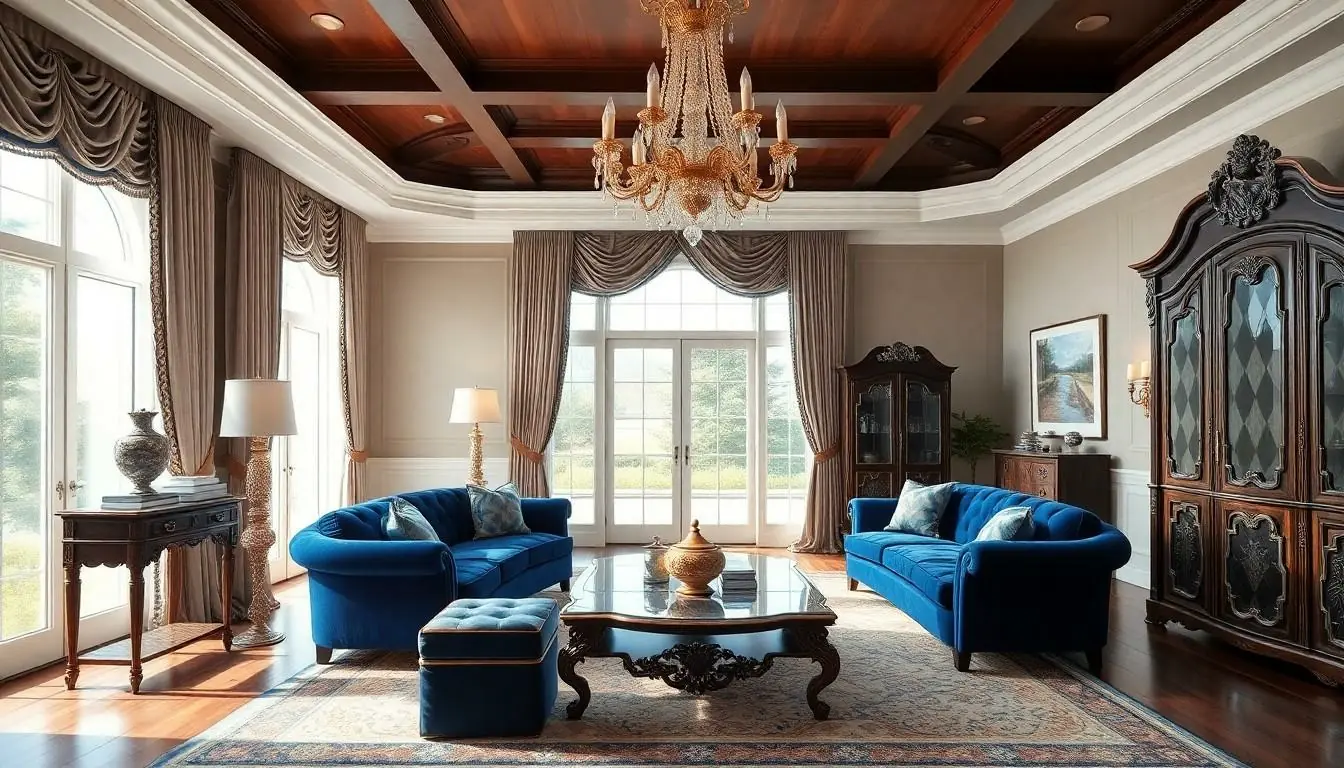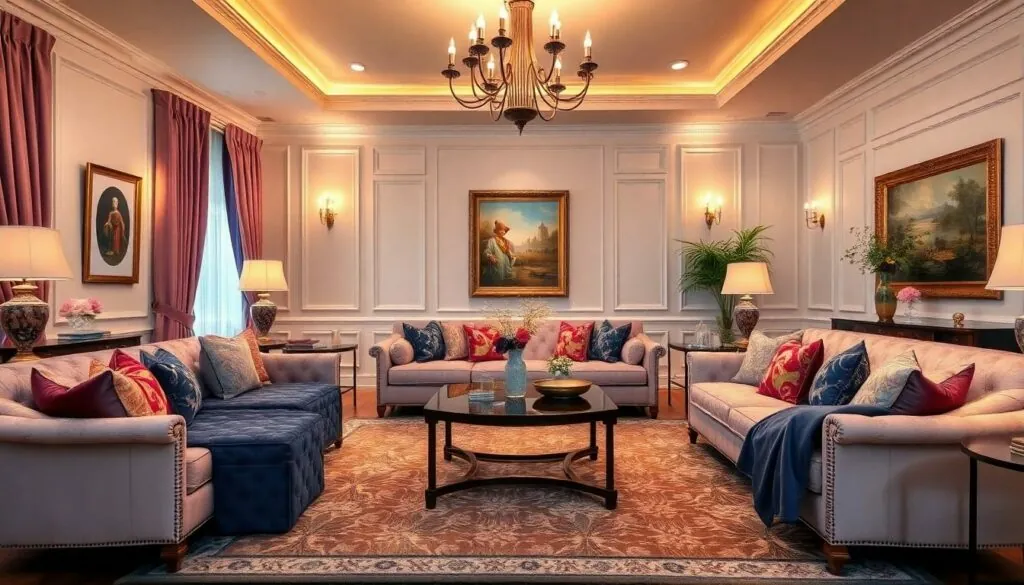Table of Contents
ToggleFormal living rooms often carry a reputation for being as stiff as a board. But they don’t have to be! Imagine a space where elegance meets comfort, where you can host a sophisticated soirée or simply kick back with a good book. It’s all about striking the perfect balance between style and relaxation.
Overview of Formal Living Rooms
Formal living rooms serve as defined spaces designed for hosting guests and engaging in social interactions. These areas emphasize elegance while providing comfort.
Definition and Purpose
A formal living room is a designated area within a home for hosting visitors, showcasing sophistication, and enhancing social connections. These rooms often serve multiple purposes, from entertaining guests to creating a serene environment. Traditionally, formal living rooms feature a more refined aesthetic compared to casual spaces, focusing on presentation and atmosphere. This balance encourages meaningful interactions while highlighting the homeowner’s style. By prioritizing design and function, formal living rooms cultivate an inviting setting for gatherings.
Key Characteristics
Key characteristics that define formal living rooms include style, furniture selection, and layout. Often characterized by traditional or elegant decor, these rooms incorporate quality materials and well-coordinated color palettes. Furniture typically features classic shapes, while seating arrangements foster conversation and connection. Decorative elements such as artwork, curtains, and area rugs enhance the overall ambiance. Lighting plays a crucial role, with fixtures that accentuate the room’s sophistication and warmth. These components work together to create a welcoming environment, ideal for hosting formal events or intimate gatherings.
Design Elements of Formal Living Rooms

Formal living rooms feature design elements that emphasize elegance while creating a welcoming atmosphere. Key aspects include furniture choices, color palettes, and lighting options, all of which contribute to the overall ambiance.
Furniture Choices
Selecting furniture for formal living rooms focuses on style and functionality. Sofas and chairs often come in luxurious fabrics such as silk or velvet, enhancing the room’s elegance. Additionally, classic designs like tufted sofas or wingback chairs foster conversation and provide comfort. Coffee tables generally serve a dual purpose, acting as surface space for decor while encouraging relaxation. Accent tables can help create distinct seating arrangements, offering both practicality and aesthetic appeal. Choosing a statement piece, such as a grand piano or antique armoire, significantly elevates the room’s sophistication.
Color Palettes
Color palettes set the tone for formal living rooms, balancing sophistication with warmth. Neutral shades like beige, cream, and gray provide a versatile backdrop, allowing decorative elements to shine. Deep jewel tones such as emerald green or royal blue can also make bold statements, adding depth. Pairing these colors with metallic accents like gold or silver brings a modern touch to traditional spaces. Layering different shades creates visual interest and depth, essential for an inviting atmosphere. Lastly, using soft pastels can evoke tranquility while maintaining elegance, making this choice popular for creating serene settings.
Lighting Options
Lighting enhances the elegance of formal living rooms, influencing both mood and perception. Chandeliers often serve as focal points, offering dramatic flair and old-world charm. Wall sconces can provide ambient lighting, adding a soft glow to the space. Table lamps with intricate designs contribute to targeted illumination, perfect for reading or conversation. Dimmers allow flexibility in brightness levels, accommodating both lively gatherings and quiet evenings. Incorporating natural light through large windows or elegant drapery further enriches the environment, creating an inviting and sophisticated atmosphere. Opting for layered lighting ensures that every corner of the room feels warm and welcoming.
Decorating Tips for Formal Living Rooms
Decorating a formal living room involves balancing elegance and comfort. Thoughtful choices create a welcoming yet sophisticated atmosphere.
Accessorizing with Elegance
Selecting accessories plays a crucial role in enhancing a formal living room. Use decorative items like vases, candle holders, and sculptural pieces to achieve a refined look. Choose items that reflect the room’s color scheme, ensuring cohesion throughout. Incorporate mirrors to amplify natural light, making the space feel larger and brighter. Opt for a few statement pieces rather than cluttering surfaces with numerous small items. A well-curated collection of accessories adds personality without overwhelming the overall design.
Choosing the Right Artwork
Artwork serves as a focal point in formal living rooms. Choose pieces that resonate with the room’s ambiance and color palette. Opt for large canvases or framed prints that capture attention without being overly dominating. Classic themes, such as landscapes or abstract pieces, can enhance sophistication. Arrange artwork at eye level for maximum impact. Consider a gallery wall to showcase several artworks, providing visual interest while maintaining an elegant aesthetic.
Incorporating Textiles
Textiles add warmth and texture to formal living rooms. Select rugs, curtains, and throw pillows that complement the existing decor. Luxurious fabrics like silk, velvet, and linen contribute to an upscale feel. Layering textiles offers a dynamic look; try combining patterned pillows with solid-colored ones. Use area rugs to define spaces and create comfort in seating areas. Ensure textiles match the desired ambiance of the room, highlighting elegance while inviting relaxation.
Common Mistakes to Avoid
Creating a formal living room can lead to common pitfalls that detract from its intended elegance and comfort. Awareness of these mistakes enhances the space’s overall appeal.
Overcrowding the Space
Overcrowding leads to a cramped atmosphere that stifles conversation. Choosing furniture pieces that are too large or numerous affects movement and accessibility. Maintaining open pathways creates a sense of flow and encourages interaction among guests. Selecting a few key furnishings ensures each piece serves a purpose without overwhelming the room’s aesthetics. Balance is essential; allowing ample space around furniture promotes a more inviting and elegant environment.
Ignoring Functionality
Functionality is critical in a formal living room. Selecting pieces solely for their appearance can result in a beautiful but impractical layout. Ensuring that furniture facilitates conversation and relaxation enhances the room’s usability. Adding versatile items, such as ottomans or side tables, provides additional surfaces without sacrificing style. Prioritizing comfortable seating options allows guests to enjoy long-lasting gatherings, blending elegance and practicality seamlessly.
Transforming a formal living room into an inviting space is entirely achievable with the right approach. By balancing elegance with comfort, these rooms can become welcoming environments for both social gatherings and intimate moments. Thoughtful furniture choices and strategic decor can elevate the atmosphere while promoting interaction among guests.
Incorporating layered lighting and quality textiles adds warmth and enhances the overall aesthetic. Avoiding common pitfalls, like overcrowding, ensures the space remains functional and inviting. With careful planning and design, formal living rooms can truly shine as sophisticated yet comfortable areas that reflect personal style and foster connection.




